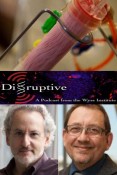DISRUPTIVE DISRUPTIVE: CONFRONTING SEPSIS – Don Ingber and Mike Super
Written on October 2nd, 2015
Wyss Institute for Biologically Inspired Engineering
DISRUPTIVE: CONFRONTING SEPSIS
Terrence McNally interviews Don Ingber and Mike Super
[00:04] Hello, I’m Terrence McNally and you’re listening to DISRUPTIVE the podcast from Harvard’s Wyss Institute for Biologically Inspired Engineering.
The mission of the Wyss is to: Transform healthcare, industry, and the environment by emulating the way nature builds.
Our bodies — and all living systems — accomplish tasks far more sophisticated and dynamic than any entity yet designed by humans. By emulating nature’s principles for self-organizing and self-regulating, Wyss researchers develop innovative engineering solutions for healthcare, energy, architecture, robotics, and manufacturing.
They focus on technology development and its translation into products and therapies that will have an impact on the world in which we live. So the Wyss is not interested in making incremental improvements to existing materials and devices, but in shifting paradigms. In this episode of DISRUPTIVE, we will focus on: CONFRONTING SEPSIS
Sepsis is a bloodstream infection in which the body’s organs become inflamed and susceptible to failure. The leading cause of hospital deaths, sepsis kills at least eight million people worldwide each year.
It can be caused by 6 species of fungi and 1400 species of bacteria. Diagnosis takes two to five days, and every hour you wait can increase the risk of death by 5-9%. The treatment challenge grows more complex as the prevalence of drug-resistant bacteria increases while the development of new antibiotics lags.
“Even with the best current treatments, sepsis patients are dying in intensive care units at least 30% of the time,” says one of today’s guests, Wyss Senior Staff Scientist Mike Super.
A new device developed by a team at Wyss and inspired by the human spleen may radically transform the way we treat sepsis. Their blood-cleansing approach can be administered quickly, even without identifying the infectious agent. In animal studies, treatment with this device reduced the number of targeted pathogens and toxins circulating in the bloodstream by more than 99%.
Although we focus here on treatment of sepsis, the same technology could in the future be used for other applications, including removing microbial contaminants from circulating water, food or pharmaceutical products.
Now let’s explore the development process with Mike Super and Wyss Founding Director, Don Ingber.
[02:25] Ingber leads the Biomimetic Microsystems platform at Wyss in which micro-fabrication techniques from the computer industry are used to build functional circuits with living cells as components. He’s authored more than 400 publications and over 100 patents.
[02:40]
The seeds of Wyss’s therapeutic sepsis device go back over twenty years. I ask Don to talk about some of the earlier explorations and findings that laid the foundations for the current work.
Ingber:
[02:51] I was interested in mechanics and biology, this idea that mechanical forces are as important as chemicals and genes, and that the shape of the cell is important. To get at testing that, I come up with the idea of using little magnetic particles that I would coat with molecules that would bind to specific receptors on cells.
Continue reading “DISRUPTIVE DISRUPTIVE: CONFRONTING SEPSIS — Don Ingber and Mike Super”

